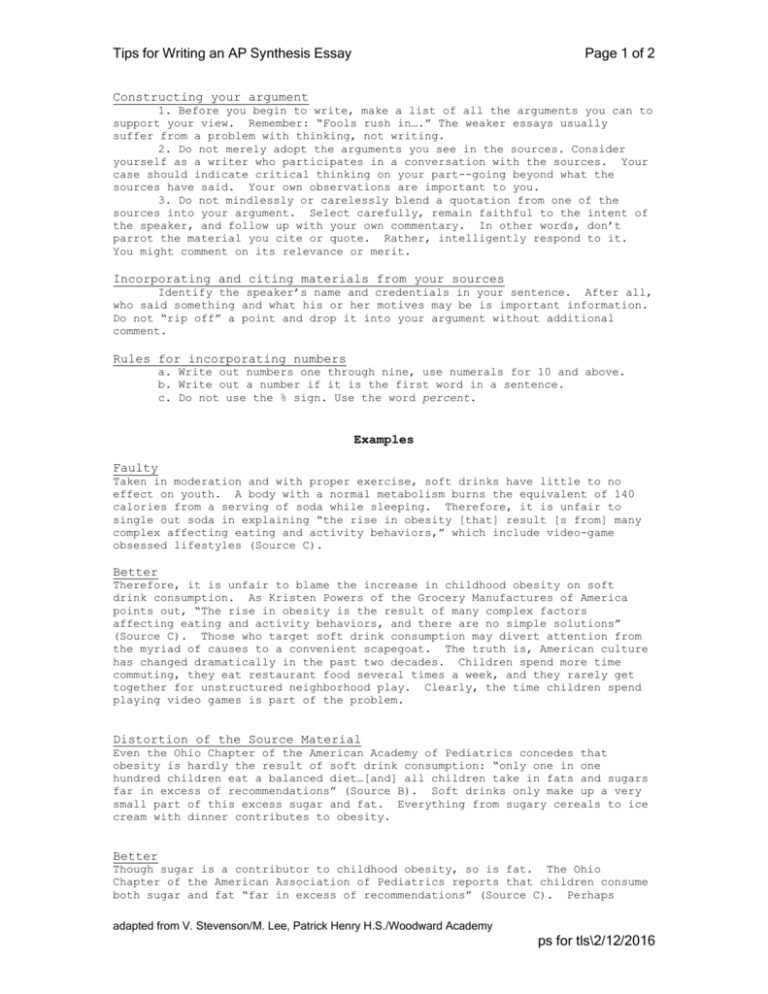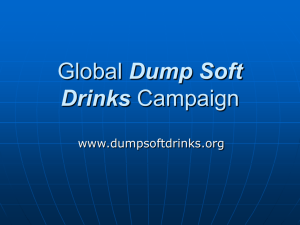Tips for writing the AP Synthesis ESSAY
advertisement

Tips for Writing an AP Synthesis Essay Page 1 of 2 Constructing your argument 1. Before you begin to write, make a list of all the arguments you can to support your view. Remember: “Fools rush in….” The weaker essays usually suffer from a problem with thinking, not writing. 2. Do not merely adopt the arguments you see in the sources. Consider yourself as a writer who participates in a conversation with the sources. Your case should indicate critical thinking on your part--going beyond what the sources have said. Your own observations are important to you. 3. Do not mindlessly or carelessly blend a quotation from one of the sources into your argument. Select carefully, remain faithful to the intent of the speaker, and follow up with your own commentary. In other words, don’t parrot the material you cite or quote. Rather, intelligently respond to it. You might comment on its relevance or merit. Incorporating and citing materials from your sources Identify the speaker’s name and credentials in your sentence. After all, who said something and what his or her motives may be is important information. Do not “rip off” a point and drop it into your argument without additional comment. Rules for incorporating numbers a. Write out numbers one through nine, use numerals for 10 and above. b. Write out a number if it is the first word in a sentence. c. Do not use the % sign. Use the word percent. Examples Faulty Taken in moderation and with proper exercise, soft drinks have little to no effect on youth. A body with a normal metabolism burns the equivalent of 140 calories from a serving of soda while sleeping. Therefore, it is unfair to single out soda in explaining “the rise in obesity [that] result [s from] many complex affecting eating and activity behaviors,” which include video-game obsessed lifestyles (Source C). Better Therefore, it is unfair to blame the increase in childhood obesity on soft drink consumption. As Kristen Powers of the Grocery Manufactures of America points out, “The rise in obesity is the result of many complex factors affecting eating and activity behaviors, and there are no simple solutions” (Source C). Those who target soft drink consumption may divert attention from the myriad of causes to a convenient scapegoat. The truth is, American culture has changed dramatically in the past two decades. Children spend more time commuting, they eat restaurant food several times a week, and they rarely get together for unstructured neighborhood play. Clearly, the time children spend playing video games is part of the problem. Distortion of the Source Material Even the Ohio Chapter of the American Academy of Pediatrics concedes that obesity is hardly the result of soft drink consumption: “only one in one hundred children eat a balanced diet…[and] all children take in fats and sugars far in excess of recommendations” (Source B). Soft drinks only make up a very small part of this excess sugar and fat. Everything from sugary cereals to ice cream with dinner contributes to obesity. Better Though sugar is a contributor to childhood obesity, so is fat. The Ohio Chapter of the American Association of Pediatrics reports that children consume both sugar and fat “far in excess of recommendations” (Source C). Perhaps adapted from V. Stevenson/M. Lee, Patrick Henry H.S./Woodward Academy ps for tls\2/12/2016 Tips for Writing an AP Synthesis Essay Page 2 of 2 those concerned about what children eat should turn their attention to what school cafeterias pile on the students’ plates rather than what schools make available in vending machines. Two slices of pizza with French fries on the side comprise the typical school lunch. Faulty A more fundamental point which I feel cannot be expressed enough is that schools exist to educate our children, and a partnership with a large corporations seems destined only to detract from that goal of learning. Just as it makes perfect sense for companies to influence elementary school students because of that crucial time when “children are still establishing their tastes and habits,” it makes perfect sense for those concerned about education to keep them out because the aforementioned crucial habits include studying, reading, and paying attention to the teacher over the soda machine (Source F). Better Schools exist to educate out children, and partnerships with large corporations seem destined to detract from learning. The fact that elementary school students are easily molded is not lost on the soft drink companies. As a writer for Beverage Industry noted, “Influencing elementary school students is very important to the soft drink marketers because children are still establishing their tastes and habits” (Source F). Just as it makes “perfect sense” for companies to influence elementary school students because they are at a crucial time in their development, it makes perfect sense for those concerned about education to keep soft drink advertising and consumption out. Elementary school should shape behaviors that contribute to a healthy, happy life. Students should be studying, reading and paying attention to the teacher--not the soda machine. What needs to be changed here? Childhood obesity is not the result of soda companies having contracts in schools. Opponents of this practice use obesity as an excuse. Like most excuses, it simply masks the whole truth. It is true that many children are obese because they “take in fats and sugars…far in excess of recommendations,” (Source B) but they do so of their own free will. Some may claim that having advertisements in schools leads children to feel pressured to consume a certain beverage; it does not lead children to feel pressured to drink that beverage in such excess that would lead to obesity. Only by addressing the underlying causes will obesity be eliminated. Also, when states pass such bills, “they restrict the authority of local schools and school districts” to decide which beverage they wish to make available to their students (Source C). adapted from V. Stevenson/M. Lee, Patrick Henry H.S./Woodward Academy ps for tls\2/12/2016









